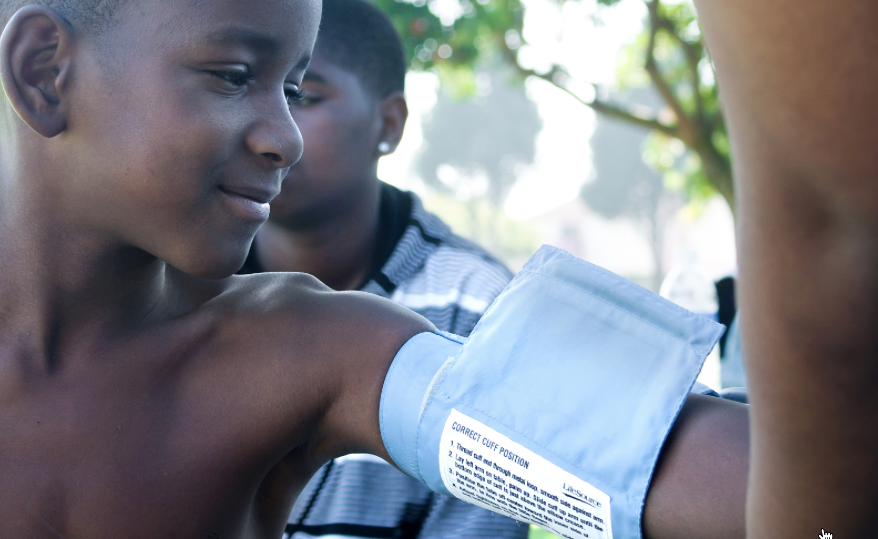Populations of African descent: New trait loci for hypertension

Last Updated on May 15, 2017 by Joseph Gut – thasso
May 14, 2017 – Hypertension is a leading cause of global disease, mortality, and disability. Individuals of African descent suffer a disproportionate burden of hypertension and its complications. To date, there has been little information on the possible genetic background (i.e., genetic susceptibility) of hypertension in individuals of African descent.
 In a study published in PLOS Genetics this week, a research team under the supervision of X. Zhu ( Department of Epidemiology & Biostatistics, School of Medicine, Case Western Reserve University, Cleveland, OH, USA) and N. Francheschini (Epidemiology, Gilling School of Global Public Health, University of North Carolina, Chapel Hill, North Carolina, USA) has addressed this question.
In a study published in PLOS Genetics this week, a research team under the supervision of X. Zhu ( Department of Epidemiology & Biostatistics, School of Medicine, Case Western Reserve University, Cleveland, OH, USA) and N. Francheschini (Epidemiology, Gilling School of Global Public Health, University of North Carolina, Chapel Hill, North Carolina, USA) has addressed this question.
In order to identify novel susceptibility loci for blood pressure and hypertension in individuals of African ancestry, the researchers performed both single and multiple-trait genome-wide association analyses. They analyzed 21 genome-wide association studies (GWAS) comprised of 31’968 individuals of African ancestry, and validated their results with additional 54’395 individuals from multi-ethnic studies. These analyses identified nine genetic loci with eleven independent variants which reached genome-wide significance for either systolic and diastolic blood pressure, hypertension, or for combined traits. Single-trait analyses identified two loci (TARID/TCF21 and LLPH/TMBIM4) and multiple-trait analyses identified one novel locus (FRMD3) for blood pressure. At these three loci, as well as at GRP20/CDH17, associated variants had alleles common only in populations of African ancestry.
In fact, the most significant variants at TARID/TCF21, FRMD3, GPR20, and CDH17 are common variants in African-ancestry individuals with hypertension, but monomorphic or low frequency in non-African-ancestry populations. For example, rs115795127 at FRMD3 is rare in European populations and absent in East Asian and Hispanic/Latino populations. Therefore, they could preciously not be identified in GWAS of non-African-ancestry populations even when increasing sample sizes.
This work nicely demonstrates once more how trait loci for clinical phenotypes may very unequally be distributed among populations of different ethnic ancestries. In the present case, it remains to be learned if allelic variants at the TARID/TCF21, LLPH/TMBIM4, FRMD3, and GRP20/CDH17 loci will become actionable for theragenomics-based therapies for hypertension specifically targeted to patients of African decent. If so, this may be significant in clinical practice for at least two reasons. First, in mixed populations presenting to the treating physician, the Caucasian patient with hypertension may have to be treated quite differently from the patient with African descent. Second, classical therapies for hypertension clinically developed in studies with a certain bias towards Caucasian populations with a certain overall underrepresentation of other ethnicities, may not be adequate for the majority of patients in regions where one of these latter ethnicities is prevalent; in the present case, that probably would apply for Sub-Saharan African countries.
Related articles across the web
 Understanding genetic variations in black women could improve cancer outcomes
Understanding genetic variations in black women could improve cancer outcomes New Genetic Links Underlying Progressively Blinding Eye Disease Found
New Genetic Links Underlying Progressively Blinding Eye Disease Found High Blood Pressure Treatment Improved Through Simple Blood Tests in African Countries
High Blood Pressure Treatment Improved Through Simple Blood Tests in African Countries Program Aims To Curb Health Habits At Church
Program Aims To Curb Health Habits At Church Healthy Living: The Benefits of Walking at Work
Healthy Living: The Benefits of Walking at Work
Related posts
Soccer Headers Might Be More Risky for APOE4 Genotype Carriers
Pharmacogenomics for infectious diseases in sub-Saharan Africa: Successes and op...
Ofatumumab (Arzerra) approved for recurrent or progressive chronic lymphocytic l...
As a parent, you probably have never thought about this: Overly picky eating cou...
Venetoclax (Venclexta) for the treatment of patients with chronic lymphocytic le...
Ph.D.; Professor in Pharmacology and Toxicology. Senior expert in theragenomic and personalized medicine and individualized drug safety. Senior expert in pharmaco- and toxicogenetics. Senior expert in human safety of drugs, chemicals, environmental pollutants, and dietary ingredients.

